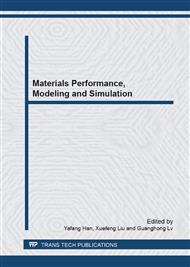[1]
R.H. Yu, The Empirical Electron Theory of Solids and Molecules, Chin. Sci. Bull. 23 (1978) 217-224.
Google Scholar
[2]
C. Lin, Z.L. Liu, Y.Q. Zhao, Theoretical Research on phase Transformations in Metastable β-Titanium Alloys, Metall. Mater. Trans A. 40(2009)1049-1058.
DOI: 10.1007/s11661-009-9798-0
Google Scholar
[3]
Z.L. Liu, Z.L. Li, Z.G. Sun, Catalysis Mechanism and Catalyst Design of Diamond Growth, Metall. Mater. Trans A. 30(1999)2757-2766.
DOI: 10.1007/s11661-999-0113-x
Google Scholar
[4]
Y.J. Gao, X.H. Hou, Q.F. Mo, C.Y. Wei et al. Atomic bonding of precipitate and phase transformation of Al–Cu–Mg alloy, J. Alloys. Compd. 441(2007)241–245.
DOI: 10.1016/j.jallcom.2006.09.088
Google Scholar
[5]
Z.L. Liu, W.D. Liu, C. Lin, Prediction of end-roll strength and rapid adjustment of the on-the-spot composition in automobile cross-beam steel, Pro. Nat. Sci. 14(2004)1104-1108.
DOI: 10.1080/10020070412331344881
Google Scholar
[6]
Z.L. Liu, W.D. Liu, C. Lin, Strength calculation and its prediction of non quenched-temepered steel during continuous casting rolling, Acta Metall. Sinica. 40 (2004)1248-1252.
Google Scholar
[7]
Z.L. Liu, C. Lin, Y. Liu, Y.C. Guo, Calculation of the end-rolling strength in Q235 strip steel by the alloying electron structure parameters, Prog. Nat. Sci. 15(2005)252-257.
DOI: 10.1080/10020070512331342070
Google Scholar
[8]
Z.L. Liu, C. Lin, Y. Liu, Y.C. Guo, Calculation of the yield and tensile strenth in the alloying non quenched-tempered steel by the electron structure parameters, Prog. Nat. Sci. 15(2005)832-837.
DOI: 10.1080/10020070512331342990
Google Scholar
[9]
Z.L. Liu, C. Lin, Theortetical calculation of the finishing rolling elogation in non-quenched and tempered Si-Mn steel, Prog. Nat. Sci. 16(2006)78-83.
Google Scholar
[10]
Z.L. Liu, C. Lin, Y.C. Guo, Theoretical calculation of the finishing rolling elongation in alloying non-quenched and tempered steel, Prog. Nat. Sci. 16(2006)859-867.
DOI: 10.1080/10020070612330080
Google Scholar
[11]
Z.L. Liu, C. Lin, Y.C. Guo, Theoretical calculation of the impact work in alloying non-quenched and tempered steel, Sci. China, Ser. E. 49(2006)257-273.
DOI: 10.1007/s11431-006-0257-5
Google Scholar
[12]
Z.L. Liu Z.L. Li, W.D. Liu, Interface electron structure and interface performance, Science Press., Beijing, 2002, pp.80-163.
Google Scholar
[13]
R.L. Zhang, Experience Electron Theory of Solid and Molecule, Jilin Science and Technology Press., Chang Chun, 1993, pp.275-300.
Google Scholar
[14]
Y.X. Liu, Theory of metal heat-treatmen, China Machine Press., Beijing, 1981, pp.216-228.
Google Scholar


